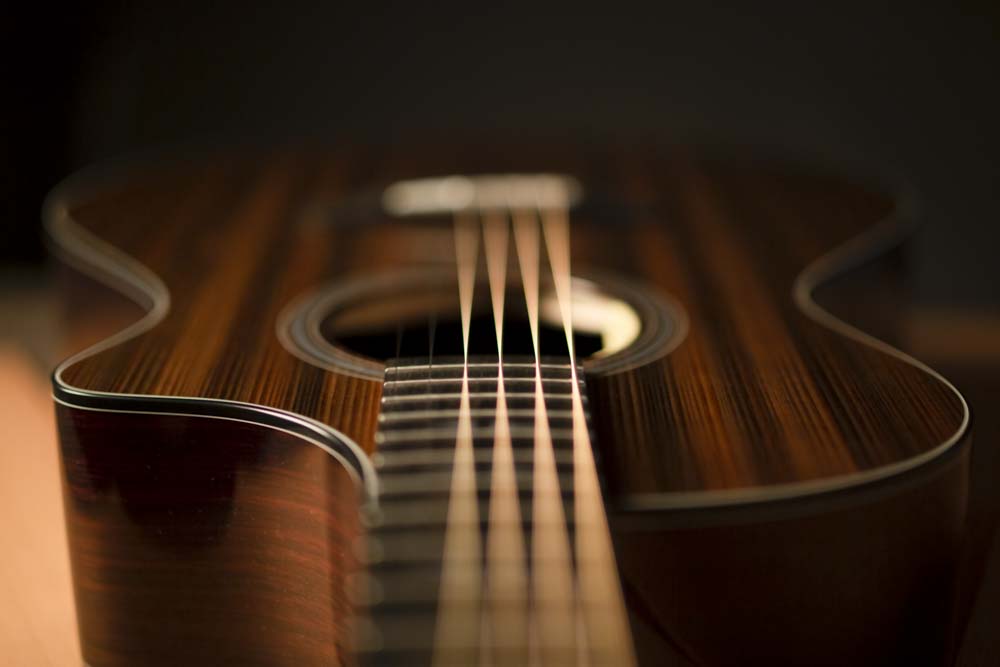
If you’ve been around acoustic guitars for five minutes, you’ve heard about solid tonewood guitars. You’ve heard that solid is better than laminate construction. You’ve also been told that solid tonewood guitars “open up” over time. But what does it all mean? More importantly, is it all true?
As with everything in acoustic guitar building, the answer is much more nuanced than the forums make it sound. So we’ve decided to demystify the subject. We’ll discuss the history and background of solid tonewood construction, lay out the differences between it and laminate construction, and wrap it up with the main benefits of sticking with solid wood.
Definitions
Solid tonewood construction
Guitars crafted by utilizing a single piece (or book-matched pairing) of wood for each surface.
Laminate construction
Guitars crafted by utilizing laminate sections of wood, which are made by layering multiple thin veneers together.
EcoTonewood Technology
Breedlove’s proprietary lamination process using genuine African mahogany as the core layer for enhanced tonal properties.
Some Background on Tonewoods
The first acoustic guitars were mainly crafted from solid tonewoods, but the reason might surprise you. Back then, woods we consider rare today were more than plentiful. Cutting them to shape was also faster and easier than laminating multiple pieces.
Plentiful materials + simple manufacturing = cheaper.
Laminate wood construction was a “new technology” designed to add strength and rigidity to guitars’ backs and sides. It was considered an upgrade. Today, that’s all changed. Advances in manufacturing and dwindling tonewood supplies make it the more affordable option for builders. But price does not define which construction method is “better.”
What Makes Solid Tonewood Different
The reason solid tonewood construction is still the standard for high-end and boutique acoustic guitars comes down to the sound. Simply put, a solid piece of wood can vibrate much better than three layers and some glue. It will be louder, clearer, and more harmonically complex, depending on a thousand other design elements. Because of this, even quality, affordable guitars, like our Designed in Bend series, also feature solid tonewood tops.
Solid wood also sounds better over time. As the wood ages and breaks in from use, its cellular structure breaks down. Though not great for you and me, this is wonderful for an acoustic guitar’s soundboard. The process accentuates everything you love about your guitar’s voice. The lows are warmer, the detail is more articulate, and the volume can even increase.
If solid tonewood guitars are so great, why would anyone want a laminate acoustic guitar? Because solid tonewood construction also has its share of considerations. The first and most important is structural integrity.
Remember how laminate construction was created to add rigidity? That remains true today. While solid woods are susceptible to warping and cracking under extreme environmental conditions, laminates aren’t. Laminate acoustic guitars are fantastic for gigging musicians and players who live where the seasons bring extreme humidity and temperature shifts.
On top of that, some luthiers prefer laminate’s added strength for their guitars’ backs and sides. Their thought is that the rest of the soundbox should hold the top tight, keeping most of the vibrational energy there. You’ll see this approach in some artisan instruments of the highest quality.
Breedlove EcoTonewood Technology
Not all laminate construction is created equal. Mostly, the process is reserved for saving money on materials for a company’s inexpensive models. In this approach, while the advertised wood may be the outermost layer, the others are cheaper, softer woods that rob the guitar of its tone.
Our EcoTonewood Technology is different. We specify only genuine African mahogany in our layering process. This ensures every piece of wood on your guitar is actually tonewood and adds to the character and voice of the instrument. And, of course, all of the wood is individually harvested and clear-cut free.
The Benefits of Solid Tonewood Guitars
The common consensus is that solid tonewood guitars sound better. We have to say that, all things being equal, we agree. But tone does remain subjective. We can say definitively that solid wood vibrates more freely and only improves with time. While there is a time and place for layered techniques, we’ve never heard of someone playing a guitar crafted from premium solid tonewoods and not preferring it.
In Conclusion
It’s challenging to write an article about solid vs. laminate tonewood construction without sounding preferential to one or being overly wishy-washy on the subject. For instance, solid tonewood does sound better, but it’s not better.
See what we mean?
The fact is that both styles have a long list of benefits over the other. Each also has its own set of considerations. The trick is to find the one that fits your needs as a guitarist. Are you slugging it out onstage while plugging in? You might want the reliability of laminate woods. Are you looking for a premium instrument for playing fingerstyle at home? Go for solid.
We hope this article gave you some insight into solid tonewood guitars, their benefits, and how they differ from laminate construction. The two are just two sides of the same coin we call crafting great acoustic guitars.
